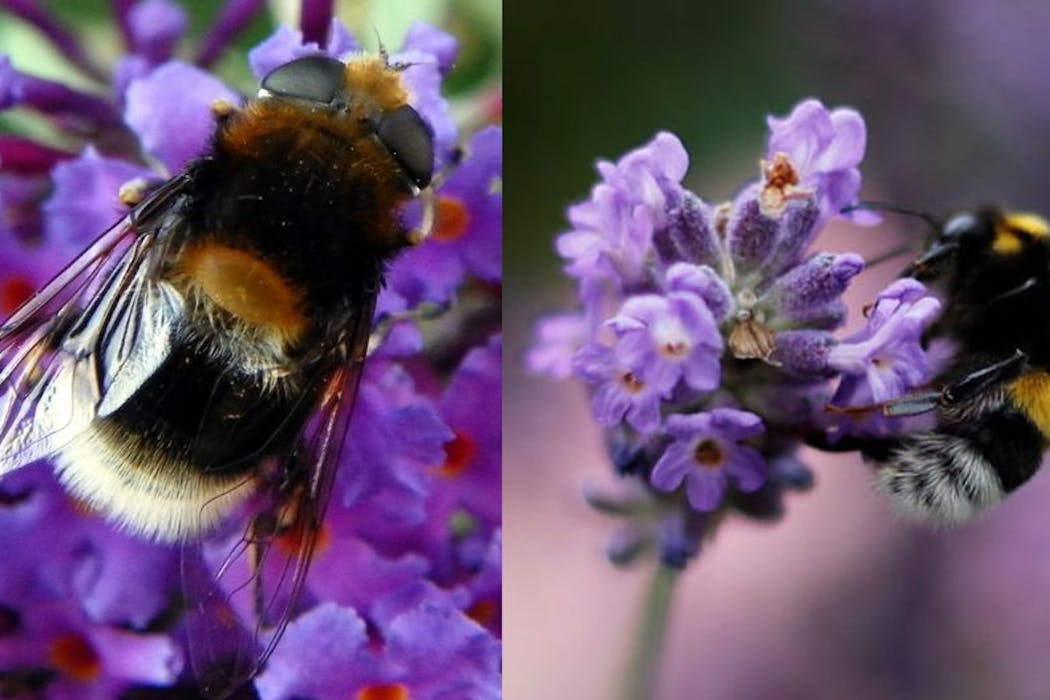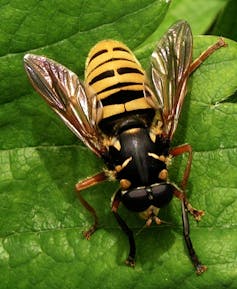
Deception is everywhere in nature. Animals and plants routinely cheat, lie and manipulate for their own benefit. One example is mimicry, where one species (the mimic) has evolved to resemble another (the model).
Authors
- James Gilbert
Senior Lecturer in Zoology, University of Hull
- Lesley J. Morrell
Professor of Bioscience Education, University of Hull
No group of animals takes this to greater lengths than hoverflies - bean-sized bullets that zip around your garden, cosplaying bees and wasps.
As some new research by ourselves and others show, hoverflies surprise not just their predators, but evolutionary biologists too.
Mimicry is most often for protection. Harmless mimics evade predators by evolving to resemble dangerous species. Some can even mimic several species . But mimicry can also be aggressive, where dangerous species dress up as innocuous ones to ambush unsuspecting prey, like the spider-tailed viper - or to steal food, like the rove beetle with a fake termite on its back.
It can be sexual. Flowers such as bee orchids resemble female insects to trick males into trying to copulate with them, unwittingly pollinating them in the process. Weedy male bluegill sunfish adopt the dark colouration of females to sneak into the brightly coloured alpha male's harem and mate with the females. Some female damselflies even mimic males just to cut themselves a break from constant harassment by males for mating.
But sometimes it's not enough just to look like your model; you have to behave like them too.

Take hoverflies, for example. Some hoverflies are highly accurate mimics, like Temnostoma . These amazingly wasp-like hoverflies have one notable flaw in their mimicry: typical short stubby fly antennae. Wasp antennae are long. But a recent study shows that Temnostoma species have evolved to mimic the long, ever-moving antennae of wasps by waving their forelegs in front of their head. Their legs have also changed from orange to black for that purpose. Stilt-legged flies do the same thing .
Other hoverflies adopt the characteristic flight patterns of their models. Butterflies mimicking other, poisonous butterflies do this too, as do spiders that walk like ants , and even a lizard that walks like a beetle .
In a new paper out this week, we and colleagues from the Universities of Hull and Nottingham showed how bumblebee-mimicking hoverflies take behavioural mimicry to the next level.
Bumblebees love blue and purple flowers, unlike wasps and many solitary bees and most flies which usually visit yellow and white flowers. A keen-eyed predator could theoretically spot a tasty fly - even one that looks like a bee - just by the colour of the flower it is visiting.
We predicted that those hoverflies that mimic bumblebees would have switched their preference to visit blue flowers. To test this we looked at nearly a thousand pictures of insects visiting flowers posted on the web by amateur enthusiasts. We looked at the colours of the flowers in the photos, comparing their "blueness" and "yellowness".
When in Rome
Bumblebees tended to be snapped on flowers with more of a "blue" component than other insects (and less of a "yellow" component). What surprised us was how closely the mimics followed the bumblebees in the blueness of the flowers they visited.
Most likely these flies have evolved to hang out in the right places to enhance their cover story as a bumblebee. It could also be that they may have been visiting blue flowers since before they ever evolved to be mimics. This would have brought them close to bumblebees, which may have been how mimicry began evolving in the first place.
Why would this happen just in bumblebee mimics? We think we have an idea.
In nature, while some mimics are downright astonishing, like Temnostoma, or like these moths , others are really pretty ropey to the point where it's difficult to see what they are even trying to mimic.
For protective mimicry to work, predators have to have at least one experience where they try attacking something brightly coloured to see if it is tasty, with unpleasant consequences. This teaches them to avoid these bright colours in future. In wasps, the bright colours are all broadly the same - yellow and black. This helps each individual wasp, because one clear warning signal is better than many different ones.
Do the best mimics resemble the nastiest species? Actually in many cases it's the other way round. A recent study using 3D-printed models showed that, if your model is super-nasty, even a passing resemblance to the model will be enough for predators to avoid you.
The stronger and clearer the warning signal, the easier it is for harmless charlatans to take advantage. So you can get away with looking only a bit like a wasp.
But if you mimic a species that is only mildly noxious, you need to be super-accurate , because the predator doesn't care as much if it makes a mistake. Bumblebees are not as nasty as wasps or honeybees. They are more palatable to predators and don't sting as readily. So if a fly is going to mimic a bumblebee, it had better be pretty good.
And bumblebee-mimicking hoverflies are some of the best mimics in nature - right down to the kinds of flowers they visit.
![]()
The authors do not work for, consult, own shares in or receive funding from any company or organisation that would benefit from this article, and have disclosed no relevant affiliations beyond their academic appointment.






